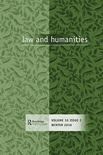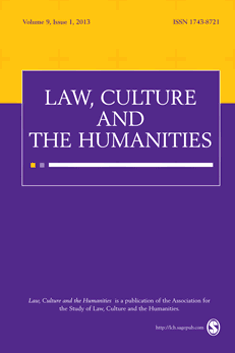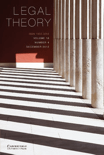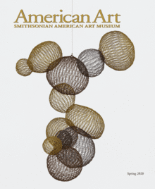
Law and Humanities
Scope & Guideline
Illuminating the Intersections of Law and Philosophy
Introduction
Aims and Scopes
- Interdisciplinary Exploration:
The journal emphasizes the convergence of law and humanities, promoting research that draws connections between legal studies and various artistic and cultural expressions. - Historical Perspectives:
Many articles reflect on historical contexts, examining how past legal frameworks and societal norms influence contemporary legal thought and artistic representation. - Legal Narratives and Representation:
A consistent focus is on how narratives—whether in literature, film, or visual arts—represent legal themes, justice, and societal issues, thereby impacting public perception and understanding of law. - Cultural Critique:
The journal encourages critical analyses of legal systems through cultural lenses, addressing issues such as power dynamics, identity, and the role of art in societal critique. - Emerging Methodologies:
It explores innovative methodologies that incorporate artistic practices into legal studies, enhancing the understanding of law through creative expressions.
Trending and Emerging
- Art and Activism:
There is a growing interest in the intersection of art and activism, particularly how artistic practices can challenge legal norms and advocate for social justice, as seen in the exploration of women's activism in historical contexts. - Law and Technology:
Emerging discussions around the implications of technology on law—such as artificial intelligence and its potential to reshape legal frameworks—indicate a trend towards integrating contemporary technological issues into legal discourse. - Narratives of Marginalization:
An increased focus on marginalized voices and narratives, particularly in relation to race, gender, and colonial histories, reflects a broader societal movement towards inclusivity and recognition of diverse experiences within legal contexts. - Emotional and Affective Dimensions of Law:
The exploration of how emotions and affective experiences relate to law is becoming more prominent, indicating a shift towards understanding the human aspects of legal processes and their impact on individuals. - Environmental and Ecological Perspectives:
Recent works highlight the relationship between law, environment, and ecology, particularly in the context of the Anthropocene, suggesting a significant engagement with environmental justice and legal responses to climate change.
Declining or Waning
- Traditional Legal History:
There has been a noticeable decrease in papers purely focused on traditional legal history without the integration of contemporary cultural critiques or artistic interpretations. - Conventional Legal Theory:
Themes centered around conventional legal theories are becoming less frequent, as the journal shifts towards more interdisciplinary and innovative approaches that incorporate broader cultural and artistic contexts. - Static Representations of Law:
The journal seems to be moving away from static or overly simplistic representations of law in literature and art, favoring more dynamic and complex interpretations that engage with current societal issues.
Similar Journals

Tijdschrift voor Rechtsgeschiedenis-Revue d Histoire du Droit-The Legal History Review
Exploring the Evolution of JurisprudenceTijdschrift voor Rechtsgeschiedenis-Revue d'Histoire du Droit-The Legal History Review is a prestigious academic journal published by BRILL, situated in the Netherlands. With a rich publication history dating back to 1920, this journal serves as a vital resource for scholars and practitioners in the fields of legal history and historical legal studies. Although it currently holds a Q4 ranking in both the History and Law categories, making it a developing journal within its domain, it has been a significant contributor to the discourse surrounding legal traditions, historical context, and the evolution of jurisprudence. Operating within the convergence years of 1920 to 2024, the journal aims to foster scholarly dialogue and promote interdisciplinary research. While it does not offer open access, the unique insights provided within its pages are invaluable for researchers, students, and professionals seeking to enhance their understanding of legal history. By focusing on critical analyses and evidence-based research, the Legal History Review inspires a robust engagement with the past to inform contemporary legal practices and policies.

Law Culture and the Humanities
Unpacking the Cultural Dimensions of Legal FrameworksLaw Culture and the Humanities, published by SAGE Publications Ltd, serves as a pivotal forum for interdisciplinary dialogue at the intersection of law and the humanities. With an ISSN of 1743-8721 and an E-ISSN of 1743-9752, this esteemed journal has been contributing to scholarly discourse since its inception in 2005 and continues to do so until 2024. The journal carries a respectable impact factor showcased through its category rankings: Q3 in Arts and Humanities (miscellaneous), Q2 in Cultural Studies, and Q3 in Law. Its Scopus rankings reflect an impressive standing in the social sciences, particularly within Cultural Studies and Law, indicating that it is a fundamental resource for researchers and professionals aiming to explore the nuanced relationships between legal frameworks and cultural expressions. While not an Open Access journal, it offers substantial insights into contemporary debates, making it essential for academics and students engaged in the study of law's cultural dimensions.

Grotiana
Exploring the Intersection of History and LawGrotiana, a prestigious journal published by BRILL, stands as a vital resource for scholars and professionals engaged in the fields of History and Law. With its ISSN 0167-3831 and E-ISSN 1876-0759, this journal has been a beacon of academic inquiry since its inception, covering a diverse array of topics with an emphasis on legal history and historical jurisprudence. Grotiana holds a commendable impact within the academic community, reflected in its 2023 Scopus ranks indicating a 91st percentile in History and a 67th percentile in Law, underscoring its significance in interdisciplinary studies. Although not an open-access journal, it offers robust access options for institutions and individuals alike, facilitating research and knowledge dissemination. Scholars can benefit from its rich historical insights and rigorous legal analysis, contributing to the ongoing dialogue in these fields. With publishing cycles spanning from 1980 to 2024, Grotiana continues to uphold its commitment to excellence, making it a pivotal player for researchers, students, and professionals pursuing a deeper understanding of historical and legal frameworks.

Legal Theory
Exploring the Foundations of Law and PhilosophyLegal Theory, published by Cambridge University Press, stands as a significant academic journal dedicated to the exploration of the conceptual foundations and implications of law within the wider realm of philosophy. Established in 1995 and maintaining a consistent publication record through 2023, the journal has garnered a reputation for its high-quality scholarly contributions, reflected in its impressive rankings: Q2 in Law and Q1 in Philosophy as of 2023. With an impactful presence in the Scopus Ranks, Legal Theory is positioned 158th in Philosophy and 337th in Law, highlighting its relevance and influence—especially within the arts and humanities. This journal serves as a critical platform for researchers, professionals, and students who seek to engage with the intricate interplay between legal norms and philosophical inquiries. Though not open access, it offers a wealth of knowledge that is integral to advancing discourse in legal philosophy, making it an essential resource for those looking to deepen their understanding of contemporary legal theories and their implications.

INTERNATIONAL JOURNAL FOR THE SEMIOTICS OF LAW-REVUE INTERNATIONALE DE SEMIOTIQUE JURIDIQUE
Illuminating Legal Discourse through Semiotic AnalysisINTERNATIONAL JOURNAL FOR THE SEMIOTICS OF LAW-REVUE INTERNATIONALE DE SEMIOTIQUE JURIDIQUE, published by Springer, stands as a vital intellectual platform within the interdisciplinary fields of law and linguistics. With an ISSN of 0952-8059 and an E-ISSN of 1572-8722, this esteemed journal has served the academic community since its inception in 1988 and continues to publish insightful research until 2024. Recognized in the 2023 rankings, it achieves Q2 status in Law and Q1 in Linguistics and Language, affirming its influence and relevance in scholarly discourse. Featuring a strong performance in Scopus rankings—comprising Rank #192 and Percentile 82nd in Language and Linguistics and Rank #254 and Percentile 75th in Law—this journal is curating high-quality contributions that explore the intersection of legal systems and semiotic theory. Despite having no open access option, it continues to disseminate important research that illuminates the semiotic dimensions of legal discourse, making it an invaluable resource for researchers, professionals, and students interested in the evolving landscape of legal and linguistic studies.

Australian and New Zealand Journal of Art
Exploring the Depths of Artistic ExpressionThe Australian and New Zealand Journal of Art, published by Taylor & Francis Ltd, stands as a critical platform for scholarly discourse in the fields of art, visual arts, and performing arts, contributing to the ongoing dialogue regarding contemporary artistic practices and methodologies across Australia and New Zealand. With an ISSN of 1443-4318 and an E-ISSN of 2203-1871, this journal invites submissions that strive for innovation and insightful critique, aiming to foster a deeper appreciation and understanding of diverse artistic expressions. Despite its classification in the fourth quartile under the Arts and Humanities categories, it continues to attract attention within its niche, as evidenced by its Scopus rankings, indicating its vital role in the academic landscape. The journal is committed to bridging the gap between research and practice, providing access to a wealth of interdisciplinary knowledge for researchers, professionals, and students alike.

ARS Orientalis
Cultivating Knowledge in the Realm of Art and ArchaeologyARS Orientalis is a distinguished academic journal published by the Smithsonian Institution's Freer Gallery of Art, specializing in the fields of archaeology, cultural studies, and the visual and performing arts. With an ISSN of 0571-1371, this journal contributes significantly to scholarly discourse, having established a robust timeline of publication since its inception, notably from 2001 to 2006, 2010 to 2012, 2014 to 2017, and resuming again from 2022 to 2023. Though currently not open access, it maintains a respectable standing in the academic community with a categorization into Q3 quartiles across several disciplines, highlighting its relevance amid rigorous scholarly evaluation. The journal is particularly valuable for researchers, professionals, and students who seek to explore interdisciplinary connections within its scope. Situated in the United States, it aims to disseminate insightful research that bridges the gap between traditional scholarship and contemporary studies in visual culture and archaeological findings.

Veredas do Direito
Navigating the complexities of contemporary law.Veredas do Direito is a prominent academic journal dedicated to the dynamic field of law, published by the esteemed Escola Superior Dom Helder Camara in Brazil. With its ISSN 1806-3845 and E-ISSN 2179-8699, this journal has established itself as an open-access platform since 2004, fostering a culture of knowledge dissemination and accessibility. It occupies a significant niche within the legal discourse, as reflected in its 2023 Scopus rankings, placing it in the 3rd quartile for Law and the 4th quartile for Management, Monitoring, Policy, and Law. The journal's scope is comprehensive, covering a wide array of legal issues relevant in contemporary society, and it significantly contributes to academics and practitioners by offering insights into effective management and legal policy. Scholars are encouraged to engage with this publication not only for its rigorous research but also for its commitment to advancing legal scholarship in Brazil and beyond, making it an indispensable resource for those committed to excellence in legal studies.

American Art
Unveiling the Cultural Significance of American ArtAmerican Art, published by University of Chicago Press, is a leading journal in the fields of cultural studies and visual arts, with a notable impact in both academic and professional circles. Since its inception in 1996, the journal has provided a robust platform for scholarly discourse, showcasing a diverse array of research that examines the evolution, context, and significance of American art and its cultural implications. With an impressive Q2 ranking in Visual Arts and Performing Arts and a Q3 ranking in Cultural Studies for 2023, American Art remains a vital resource for researchers, professionals, and students alike, facilitating a deeper understanding of the intricacies within American artistic practices. While currently not offering open access, the journal is accessible through various academic databases, ensuring reach to a wide audience dedicated to the intersection of art and culture. The journal's commitment to innovative scholarship makes it an indispensable resource for anyone seeking to explore the dynamic landscape of American art.

Law and History Review
Advancing Insights at the Crossroads of Law and HistoryLaw and History Review, published by Cambridge University Press, stands as a premier scholarly journal dedicated to advancing the interdisciplinary fields of law and history. With an ISSN of 0738-2480 and a robust E-ISSN of 1939-9022, this journal fosters a deeper understanding of legal systems through the lens of historical contexts. Notably categorized within the Q1 quartile in History and Q2 in Law as of 2023, the journal reflects a distinguished impact within the academic community, evidenced by its competitive Scopus rankings—221st out of 1,760 in Arts and Humanities for History and 436th out of 1,025 in Social Sciences for Law. Researchers, professionals, and students alike will find valuable insights in the journal's comprehensive analyses, which span from 1983 through to 2024. Though not open access, the journal is pivotal for those seeking to explore the dynamic interplay between legal traditions and historical narratives, reinforcing its importance in both legal and historical scholarship.